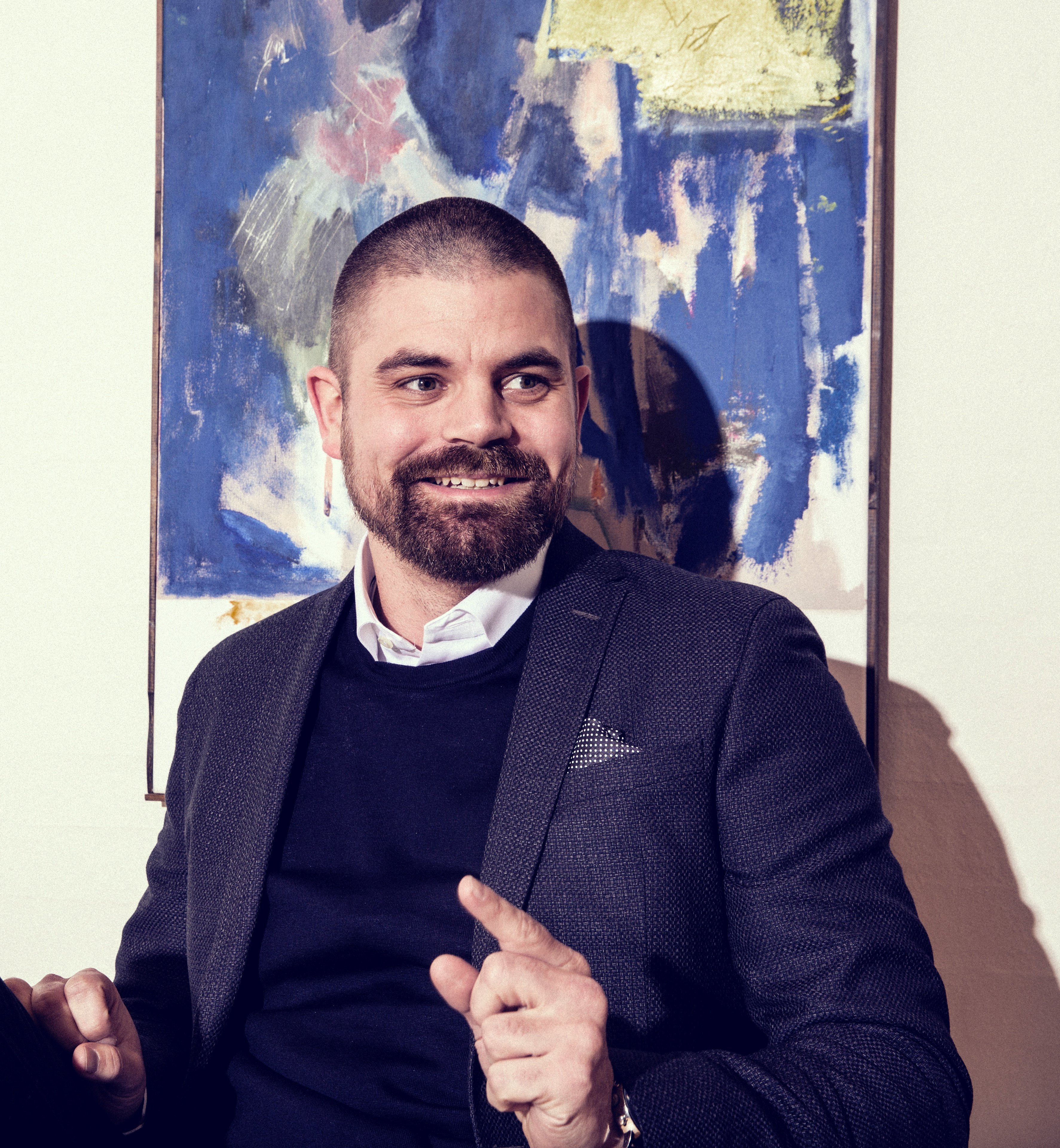
Danish collector Claus Busch Risvig only stumbled into art in 2009 by way of his in-laws, but he has been an avid art buyer ever since. By now, his varied collection, which has been shown twice in Denmark, numbers around 350 works with a focus on emerging art, including a small collection of works by artists from Iran and a strong thread of young Danish art that runs through the collection.
From his base in the picturesque town of Silkeborg, in Denmark—coincidentally also the birthplace of Asger Jorn, one of Denmark’s most celebrated 20th-century artists—Risvig, who works in the startup business, stays active on creative circuits. His favored modus operandi is visiting galleries and studios—where he prefers to see and buy art—and he is an avid storyteller on social media, where he shares the artists and works that inspire him, as well as his most recent acquisitions. He sits on the advisory board at Plop Residency in London and serves as a board member of Silkeborg Kunstnerlegat, a private funding body that grants stipends to artists to make work.
Risvig shared with Artnet News the details about his favorite artworks and his passion for the new—and how what hangs in his home is somewhat dictated by his two young children.
Installation view of works in the Bech Risvig Collection in Silkeborg, Denmark, featuring pieces by Ismar Cirkinagic, Mikkel Carl, and Hiva Alizadeh. Courtesy of the Bech Risvig Collection.
What was your first purchase?
The first artwork we bought was a pair of lithographs by the Danish artist HuskMitNavn, and the first unique piece we acquired was a porcelain sculpture titled Model Child? by the Danish artist Maria Rubinke.
What was your most recent purchase?
The most recent acquisition is a beautiful painting by the emerging Danish artist Cecilia Fiona. I’m really looking forward to following her career in the coming years—I think she’s a great talent and truly think she has a bright future ahead of her.
We also recently acquired works by emerging artists Moritz Kraus, Eglė Norkutė, Gastón Lisak, and Mike Shultis, who just opened a solo show at Ashes/Ashes in New York.
Cecilia Fiona, Blindt rækker vi ud (2021). Courtesy of the artist and the Bech Risvig Collection.
Which works or artists are you hoping to add to your collection this year?
We would love to add an aerated concrete sculpture by Danish artist Sif Itona Westerberg. Her work is really beautiful and very interesting and she has an amazing solo exhibition at the ARoS Aarhus Art Museum right now.
I would also like to add works by Pierre Knop, Stine Deja, Katelyn Ledford, Rachel Hobkirk, and many others in the near future.
What is the most expensive art work you own?
I’m not actually sure—we primarily collect emerging artists, and prices go up and down all time. It’s also much more important for us that the artists we collect have healthy careers, and hopefully get institutional recognition at some point.
Installation view of the 2021 Artland VRoom exhibition “Paintings From the Bech Risvig Collection,” featuring works by Maryam Eivazi and Marco Pariani. Image courtesy of Artland.
Where do you buy art most frequently?
We of course buy at galleries, but also directly from artists if they are not represented by a gallery. We also buy at auction, sometimes, but most works that enter our collection are from the primary market.
Is there an artwork you regret purchasing?
No. There are of course works in our collection that maybe don’t interest us that much anymore, but they are still part of our journey as collectors and have been a crucial part of developing our taste.
What work do you have hanging above your sofa? What about in your bathroom?
Above our sofa we have a beautiful painting by Norwegian artist Tyra Tingleff, and next to that we have a great textile piece by American artist Jon Young. In our bathroom, we have a piece by Kiki Smith.
Jon Young, Go (2020). Courtesy of the artist and the Bech Risvig Collection.
What is the most impractical work of art you own?
We have a few video works by people like the Danish artist Kristian Touborg and the Iranian artist Neda Zarf Saz, and we really don’t have a good way of showing them at our home. We also own some sculptures that are very impractical because of their fragility. We have two small kids, so we need to be a bit careful about where we place certain pieces!
What work do you wish you had bought when you had the chance?
A painting by Shara Hughes that I saw years ago at a Danish auction house…I still regret that I didn’t buy it. But part of being a collector is also that you can’t have it all, and sometimes you need to make choices that might haunt you afterwards.
If you could steal one work of art without getting caught, what would it be?
It would be Asger Jorn’s masterpiece Stalingrad le non-lieu oú le fou rire de courage, which was made between 1957 and 1972. We live in Silkeborg, Denmark, the hometown of Jorn and also the Museum Jorn, where the painting is hanging. It is always a great pleasure to stand in front of this amazing work, with its strong content about war and death.